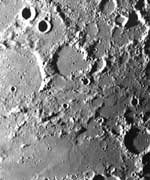
Image credit: ESA
On 17 March the ESA Council, at its meeting in Paris, unanimously approved a cooperation agreement between ESA and the Indian Space Research Organisation for India?s first moon mission ? Chandrayaan-1.
The Indian Space Research Organisation (ISRO), founded in 1969, launched its first satellite in 1975. Since then it has developed a number of launch vehicles as well as satellites for Earth observation, remote sensing, telecommunications and weather forecasting. India has its own launch site at Sriharikota but has also used Europe?s Spaceport in French Guiana to launch its satellites. Chandrayaan-1 marks its first venture into planetary space science.
Under the agreement Europe will coordinate and support the provision of three instruments: CIXS-2, the Chandrayaan-1 Imaging X-Ray Spectrometer; SARA, a Sub-keV Atom Relecting Analyzer; and SIR-2, a Near-Infrared Spectrometer. It will also support the hardware for the High-Energy X-ray Spectrometer (HEX). Direct ESA in-kind contributions are also foreseen under this historical agreement. In return, all data resulting from the instruments will be made immediately available to ESA Member States through ESA.
The instruments requested are identical to those on ESA?s SMART-1. Launched in 2003, SMART-1, having demonstrated a new solar electric propulsion motor and tested other technologies on its way to the moon, has just started its science phase. It will make the first comprehensive inventory of key chemical elements in the lunar surface.
ISRO plans to send a 1050 kg (523 kg initial orbit mass and 440 kg dry mass) remote sensing satellite to help unravel mysteries about the origin and evolution of the solar system in general and the Moon in particular. The satellite, which is expected to have an operational life of two years, will be launched by India?s Polar Satellite Launch Vehicle in 2007/2008.
ESA will give ISRO the benefit of its experience with SMART-1 and will further assist in operations facilitation as well as providing the science instruments.
ESA’s SMART-1 put Europe in the lead in the new race back to the Moon. As well as India and Japan, China and the USA also intend to launch lunar missions in the coming years. The cooperation with India will keep European scientists in the forefront.
The ESA Director of Science, David Southwood, said: “One should also see the cooperation in a wider context. Space science is a natural area for space agencies to learn to work together in technical matters. Such cooperation remains a strategic element in the Director General’s wider agenda for the Agency.”
Original Source: ESA News Release

Yeah, I always believe that all of these guys should cooperate since the bottom-line is data & science for mankind.